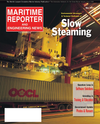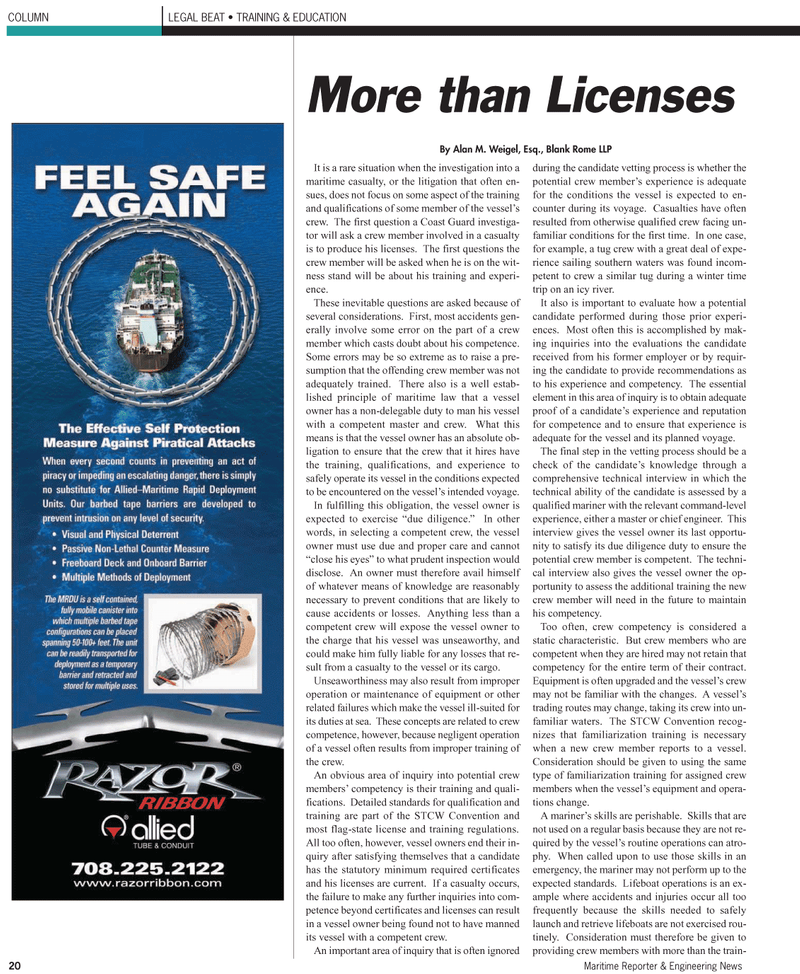
Page 20: of Maritime Reporter Magazine (May 2, 2010)
Read this page in Pdf, Flash or Html5 edition of May 2, 2010 Maritime Reporter Magazine
20 Maritime Reporter & Engineering News
It is a rare situation when the investigation into a maritime casualty, or the litigation that often en- sues, does not focus on some aspect of the training and qualifications of some member of the vessel’s crew. The first question a Coast Guard investiga- tor will ask a crew member involved in a casualty is to produce his licenses. The first questions the crew member will be asked when he is on the wit- ness stand will be about his training and experi- ence.
These inevitable questions are asked because of several considerations. First, most accidents gen- erally involve some error on the part of a crew member which casts doubt about his competence.
Some errors may be so extreme as to raise a pre- sumption that the offending crew member was not adequately trained. There also is a well estab- lished principle of maritime law that a vessel owner has a non-delegable duty to man his vessel with a competent master and crew. What this means is that the vessel owner has an absolute ob- ligation to ensure that the crew that it hires have the training, qualifications, and experience to safely operate its vessel in the conditions expected to be encountered on the vessel’s intended voyage.
In fulfilling this obligation, the vessel owner is expected to exercise “due diligence.” In other words, in selecting a competent crew, the vessel owner must use due and proper care and cannot “close his eyes” to what prudent inspection would disclose. An owner must therefore avail himself of whatever means of knowledge are reasonably necessary to prevent conditions that are likely to cause accidents or losses. Anything less than a competent crew will expose the vessel owner to the charge that his vessel was unseaworthy, and could make him fully liable for any losses that re- sult from a casualty to the vessel or its cargo.
Unseaworthiness may also result from improper operation or maintenance of equipment or other related failures which make the vessel ill-suited for its duties at sea. These concepts are related to crew competence, however, because negligent operation of a vessel often results from improper training of the crew.
An obvious area of inquiry into potential crew members’ competency is their training and quali- fications. Detailed standards for qualification and training are part of the STCW Convention and most flag-state license and training regulations.
All too often, however, vessel owners end their in- quiry after satisfying themselves that a candidate has the statutory minimum required certificates and his licenses are current. If a casualty occurs, the failure to make any further inquiries into com- petence beyond certificates and licenses can result in a vessel owner being found not to have manned its vessel with a competent crew.
An important area of inquiry that is often ignored during the candidate vetting process is whether the potential crew member’s experience is adequate for the conditions the vessel is expected to en- counter during its voyage. Casualties have often resulted from otherwise qualified crew facing un- familiar conditions for the first time. In one case, for example, a tug crew with a great deal of expe- rience sailing southern waters was found incom- petent to crew a similar tug during a winter time trip on an icy river.
It also is important to evaluate how a potential candidate performed during those prior experi- ences. Most often this is accomplished by mak- ing inquiries into the evaluations the candidate received from his former employer or by requir- ing the candidate to provide recommendations as to his experience and competency. The essential element in this area of inquiry is to obtain adequate proof of a candidate’s experience and reputation for competence and to ensure that experience is adequate for the vessel and its planned voyage.
The final step in the vetting process should be a check of the candidate’s knowledge through a comprehensive technical interview in which the technical ability of the candidate is assessed by a qualified mariner with the relevant command-level experience, either a master or chief engineer. This interview gives the vessel owner its last opportu- nity to satisfy its due diligence duty to ensure the potential crew member is competent. The techni- cal interview also gives the vessel owner the op- portunity to assess the additional training the new crew member will need in the future to maintain his competency.
Too often, crew competency is considered a static characteristic. But crew members who are competent when they are hired may not retain that competency for the entire term of their contract.
Equipment is often upgraded and the vessel’s crew may not be familiar with the changes. A vessel’s trading routes may change, taking its crew into un- familiar waters. The STCW Convention recog- nizes that familiarization training is necessary when a new crew member reports to a vessel.
Consideration should be given to using the same type of familiarization training for assigned crew members when the vessel’s equipment and opera- tions change.
A mariner’s skills are perishable. Skills that are not used on a regular basis because they are not re- quired by the vessel’s routine operations can atro- phy. When called upon to use those skills in an emergency, the mariner may not perform up to the expected standards. Lifeboat operations is an ex- ample where accidents and injuries occur all too frequently because the skills needed to safely launch and retrieve lifeboats are not exercised rou- tinely. Consideration must therefore be given to providing crew members with more than the train-
COLUMN LEGAL BEAT • TRAINING & EDUCATION
More than Licenses
By Alan M. Weigel, Esq., Blank Rome LLP

 19
19

 21
21
